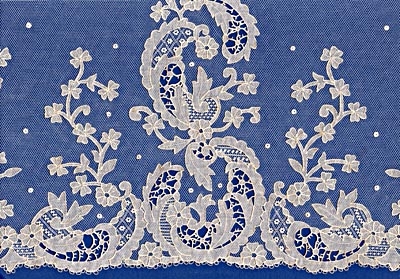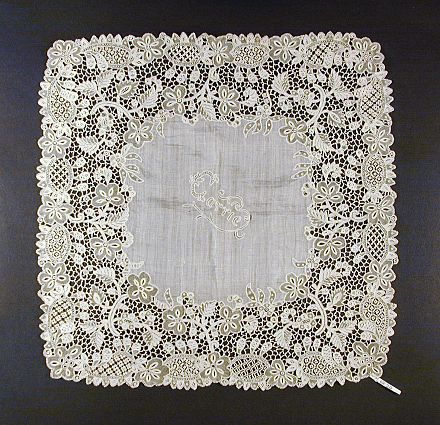IRISH LACE:-
IRISH LACE:-
Irish lace has always been an important part of the Irish needlework tradition. Both needlepoint and bobbin laces were made in Ireland before the middle of the eighteenth century, but never, apparently, on a commercial scale. It was promoted by Irish aristocrats such as Lady Arabella Denny, the famous philanthropist, who used social and political connections to support the new industry and promote the sale of Irish lace abroad. Lady Denny, working in connection with the Dublin Society, introduced lace-making into the Dublin workhouses, especially among the children there. It is thought that it was an early form of Crochet, imitating the appearance of Venetian Gros Point lace.
Image (Sample of Irish Lace in Carrickmacross lace style)
YOUGHAL LACE:-
Youghal lace (or Point d'Irlande) is a needle lace inspired by Italian needle lace and developed in Youghal, County Cork,
Ireland.
image:-(Wedding handkerchief of linen trimmed with Youghal lace)
OriginsYoughal Lace was perhaps the most successful of the nineteenth century Irish needlelaces. In 1845 Mother Mary Ann Smith (d.1872), one of the Presentation Sisters, unpicked some Italian lace to discover the techniques used to make it, and then taught them to local women. The Convent Lace School was opened in Youghal in 1852. Youghal lace was made to a high standard and employed a wide variety of motifs. It was therefore able to survive as a commercial product until the First World War, which saw the general demise of handmade lacemaking.
Characteristics:-
Youghal Lace is considered a true lace as it is created with a sewing needle and thread only. It was created in Youghal and Kenmare. It was mostly used for fans, collars, cuffs and ecclesiastical trimmings. It is a flat needlepoint lace with no cordon nets. It uses a ladder like buttonhole stitches around each motif and edges decorated with a 'Venetian Stitch' or knitted border. The designs are primarily of flowers such as roses, anemones and fuschia, with spiky shaped leaves. The shading of the petals are a result of the closeness of the buttonhole stitches.[5] There were at least fifty distinct stitches associated with Youghal Lace.[6]Irish crochet lace:-Irish crochet lace is a style of Irish lace which is generally considered allied to rather than a true lace. It was originally developed in mid-nineteenth century Ireland as a method of imitating expensive Venetian point laces.
Image 19th century Irish crochet lace.
Technique:-
Irish crochet lace was traditionally made with a very fine steel crochet hook and fine crochet linen thread, though modern Irish crochet lace is made with mercerised thread. Traditionally, there are two styles of Irish crochet. One style, or fine crochet, is made up of squares or medallions, with shamrocks or roses in the centre. The other more challenging style begins with an outline or template on a piece of cloth or thick brown paper. Each motif is then crocheted separately, using cotton cord for volume and shaping. The finished motifs are then basted (sewn with a loose stitch for temporary tacking) onto a cloth in the shape of the pattern. The motifs are then joined using chains and picots. When all the motifs have been joined together to form one piece of lace, the basting stitch is removed from the back cloth, revealing the completed lace.
Revival:-
Irish Crochet Lace, particularly Clones Lace, is experiencing a revival as modern designs are being created by Irish lace makers as well as others, such as Eastern European, Australian, Asian, South American and North American designers. Since 1990, Máire Treanor and her voluntary committee have been organising the annual Clones Lace Summer School in Clones, County Monaghan, as a gathering place for designers and students wishing to learn and preserve traditional patterns and share innovative ideas. Irish crochet lace is the original freeform crochet, with the design of each piece being individual.Ref:-https://en.m.wikipedia.org





Comments
Post a Comment